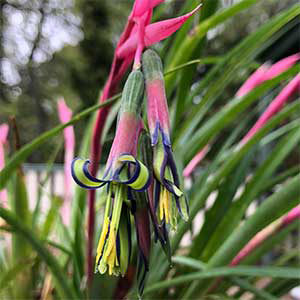Pronounced (bill bur’gee uh)

Billbergia are a group of bromeliads with the best known being Billbergia nutans commonly called ‘Queen’s Tears’ (see picture right).
Also known as the friendship plant as gardeners divide them and give them to friends, Billbergia nutans is also readily available for sale, especially when in flower. Even the Big Boxes sell this one.
A rather brilliant plant, as it is easy to grow and vigorous with the added attraction of having wonderful flowers.
It is one of those plants that needs to ‘find the right position’ once you have it growing it will flower reliably every year. We have seen them growing in hanging baskets as well as in the ground. However, ours are usually grown in containers.
This is an evergreen epiphytic species, however it is widely grown in a free draining, open, soil mix similar to a fine orchid mix.
The colorful flowers that droop gracefully down are a mixture of green, mauve and pink, set of by yellow stamens. They hang in a funnel shaped rosettes and although not long lasting are spectacular.
So Billbergia nutans with its jewel like flowers that droop down gracefully is in fact one of the easiest of all to grow.
Billbergia nutan Care
Although Billbergia nutans will grow in full sun it is best in light shade, and certainly with protection from hot afternoon sun. They grow well indoors in a well lit position especially if you can provide some humidity. In Florida you will see then growing outdoors where they seem to thrive.
- Temperature – Although Billbergia nutans will cope with low temperatures they will tend to suffer a little. Frosts and freezes need to be avoided. A summer temperature of around 70 – 80°F is ideal. However a slightly colder winter at around 60 – 70°F will improve flowering and plant health.
- Light – Try for good strong filtered light, imagine a bright forested area.
- Soil – As they are grown in a potting mix some fertilizer can be used, however Billbergia do take nutrients from the air so this is really not required.
- Fertilizer – A spray with a diluted foliar fertilizer when plants are in their growth cycle is beneficial. Some growers use a slow release fertilizer for pot grown plants, do this at 1/4 strength in late spring if you wish.
- Watering – Watering is really not required very often. Do not water if the potting mix is moist. In summer you can water more frequently than in winter. Simply check to make sure that the soil mix is dry before watering. Over watering in winter can be a problem as it can cause root rot.
- A little misting in summer will increase humidity which the plat will respond to. However the foliage should not remain wet.
- Re-Potting – When you need to re-pot, wait until flowering is over. Try to use a pot just a little larger than the one the plant is in. In general a 4 inch pot is adequate, 5 inch pot for larger plants. Once they get bigger than this it is usually time to divide them.
Propagation
Billbergia are all easily propagated by separating the offsets or ‘pups’ from the main plant, they take well and are easy to get going.
Billbergia Varieties
- Billbergia nutans – commonly known as ‘Queens Tears’
- Billbergia pyramidalis – large red flowers held in an upright manner
- Billbergia suandersii – blue, green and red flowers in showy open bracts
- Billbergia distichia – drooping flowers green with pink, not as showy as B. nutans
Summary Information
- Botanical Name : Billbergia nutans
- Common Name : Queens Tears
- Family Name : Bromeliaceae
- USDA Zone : 10 – 11
- Height : To around 18 – 24 inches
- Spread : Clump forming to around 5 inches
- Growth Rate : Medium
- Flower colour – Green, Pink Yellow and Purple
- Flowering Time – Winter to Spring depending on the zone
- Soil : Well drained
- Light : Full to part Light shade.
- Humidity : Medium
- Container Growing : Yes
- Frost Tolerance : Light to medium frosts only
- Drought Tolerant : Yes

